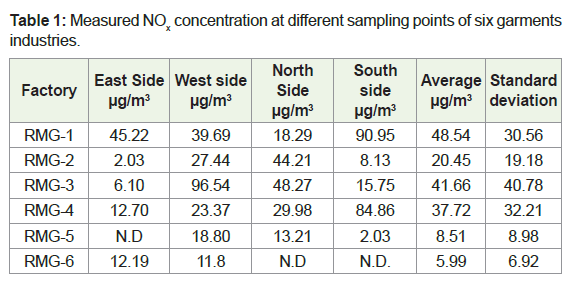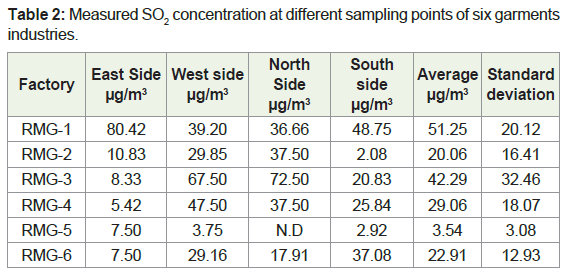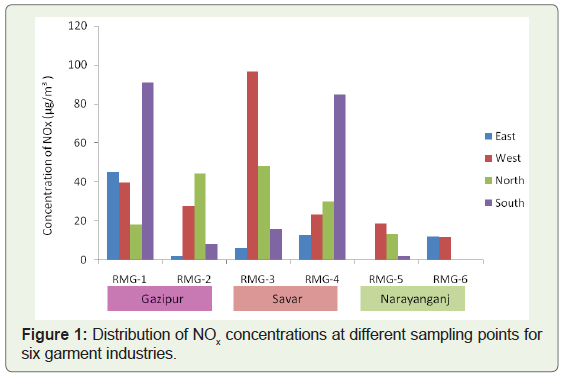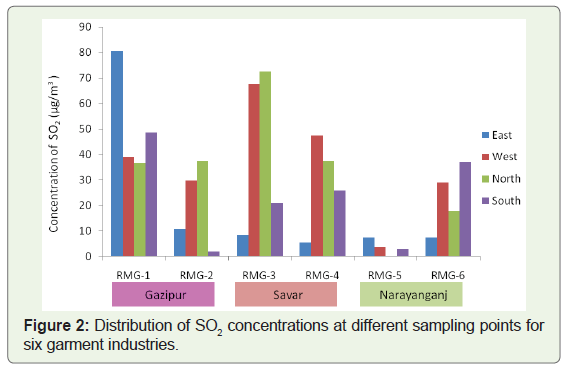Research Article
Assessment of Nitrogen Oxides and Sulphur Dioxide Content in the Ambient Air near the Garments Industries of Bangladesh
Hasan MM1, Rabbi MA2*, Maitra B2, Faruk O3, Sarwar M4 and Roy PK5
1Department of Chemistry, University of Rajshahi, Bangladesh
2Bangladesh Council of Scientific & Industrial Research (BCSIR) Laboratories, Rajshahi, Bangladesh
3Department of Applied Chemistry & Chemical Technology, University of Rajshahi, Bangladesh
4Department of Microbiology, Stamford University Bangladesh, Bangladesh
5Department of Chemistry, Mawlana Bhashani Science and Technology University, Bangladesh
Corresponding author: Rabbi MA, Bangladesh Council of Scientific & Industrial Research (BCSIR) Laboratories, Rajshahi, Bangladesh, E-mail: rabbi_chem@yahoo.com
Citation: Hasan MM, Rabbi MA, Maitra B, Faruk O, Sarwar M. Assessment of Nitrogen Oxides and Sulphur Dioxide Content in the Ambient Air near the Garments Industries of Bangladesh. J Environ Soc Sci. 2018;5(1): 132.
Copyright ©2018 Rabbi MA, et al. This is an open access article distributed under the Creative Commons Attribution License, which permits unrestricted use, distribution, and reproduction in any medium, provided the original work is properly cited.
Journal of Environmental and Social Sciences | Volume: 5, Issue: 1
Submission:28/11/2017; Accepted: 29/12/2017; Published: 03/01/2018
Abstract
The term Nitrogen Oxides (NOx), is used to describe the sum of NO, NO2 and other oxides of nitrogen and entire group of sulfur oxides expressed as SOx. Nitrogen oxides play a major role in the formation of ozone in the atmosphere and sulphur dioxide is a highly reactive gas which affects both health and the environment. A variety of NOx and SOx compounds and their products occur both naturally and as a result of human activities. Therefore continuous monitoring of these gaseous pollutants in the air is essential to control the air quality. The objective of the research work is to assess the air quality of some major industrial areas of Bangladesh. The NOx and SO2 content in the ambient air of three industrial areas have been investigated. Concentration of both gaseous pollutants in the ambient air of garments industries at Gazipur and Savar were found higher than Narayanganj. In this investigation the production house of the garment industries were marked as the main source of the NOx and SO2.
Keywords:
Nitrogen oxides; Sulphur dioxide; Ambient air; Gazipur; Savar; Narayanganj
Introduction
Air pollution is one of the serious environmental problems confronting our civilization today. Air pollution means the presence of chemicals or particles in the air which are usually not present and which lower the quality of the air or cause detrimental to human health. Although some natural processes such as volcanic eruptions and wildfires may pollute the air but most often, it is caused by human activities such as transportation, industrial work, mining, construction, agriculture, smelting, etc. The pollutants are found in both gaseous and solid form (as particulate matter suspended in the air). The air pollutants such as Particulate Matter (PM), black carbon, Ozone (O3), Nitrogen Oxides (Nox), Sulfur Oxides (SOx), carbon monoxide, heavy metals or black smoke often investigated for the assessment of air quality [1,2].
Anthropogenic emissions of nitrogen oxides are mainly the result of combustion processes, such as the combustion of fuel for vehicles or the combustion of coal, oil and natural gas for industrial processes. Most of the nitrogen oxides from diesel engines are emitted as Nitrogen Dioxide (NO2), which is five times more toxic than Nitric Oxide (NO). Nitrogen dioxide, nitric oxide and other oxides of nitrogen are collectively called as NOx [3]. Nitrogen oxides contribute to a wide range of effects on public welfare and the environment, including global warming and stratospheric ozone depletion. The atmosphere polluted with NOx reacts with water to produce nitric acid. Such a precipitation contains elevated levels of hydrogen ions and causes acid rain which is equally detrimental to plants, humans, animals and our infrastructure [4,5].
SO2 is the component of greatest concern and is used as the indicator for the larger group of gaseous Sulfur Oxides (SOx). The main source of SO2 in the atmosphere is the burning of fossil fuels by power plants and other industrial facilities. Exposure to SO2 can affect the respiratory system, especially for people with asthma. Studies show connections between short-term exposure and increased visits to emergency departments and hospital admissions for respiratory illnesses, particularly in populations at risk (including children, the elderly, and asthmatics).
Bangladesh has now emerged a potential supplier of Readymade Garments (RMG) to both North America and Europe. Above 50% of Bangladeshi garment exports go to European Union and 44% of it’s to USA [6]. Exporting of textiles and garments are the main source of foreign exchange earnings. However in terms of pollution, textile industries are one of the most polluting industries in the world [7]. With respect to environmental issue, these textile and dyeing industries now considered as a major environmental threat in the industrial area of Bangladesh [8]. Textile operation follows a huge amount of waste streams, including liquid, gaseous and solid wastes, some of which may be hazardous. Time dependent industrial operations may emit substantial quantity of atmospheric contaminants: CO, CO2, SO2, NO2, NH3, particulates and other wastes. In Bangladesh many small and medium RMG industries not only discharge untreated effluents in water but also emits air pollutants like suspended particulate matter (PM10 and PM2.5), SO2, NOx content in air indiscriminately. These emissions have not only biological and but also environmental impacts like the induction of stress on human and animal health and also responsible to on earth’s climate [9-12]. Ambient air quality monitoring is required to determine the existing quality of air, evaluation of the effectiveness of control program and to identify areas in need of restoration and their prioritization. The mean concentration of NO2 was 3.1 Parts Per Million (ppm) around the chemical industry in Kwekwe, Zimbabwe [13]. In 2010, the seasonal variability of ambient NH3, NO, NO2 and SO2 over Delhi, India has been reported by Sharma, et al. [14]. He also reported the observed concentration of NOx ranged between 9.83 μg/m3 to 216.25 μg/m3 in Gurgaon, Northern India in 2016 [15]. Tolerable range of NOx was found near cement industries Nimbahera, Rajasthan, India by Chaurasia S, et al. [16]. According to Choudhary, et al. the NOx content in the air of Rajasthan, India was found 38.39 μg/m3 - 42.43μg/m3 in 2017 [7]. Neelima N, et al. were investigated the air quality of Udaipur, Rajasthan, India and found the concentration of gaseous pollutants (SOx, NOx) below than the prescribed limit [17].
Industrial pollution is one of the problems presently facing Bangladesh [18]. Continuous monitoring and several efforts should be taken in the industrial zone to control the environmental problems. In Bangladesh, most of the garments factories are located at Gazipur, Savar and Narayanganj. Due to the saturated level of industries in this area the quality of the air is a matter of great concern. To measure quality of ambient air around garments industries, six RMG industries were taken into consideration. The main objective of this research is to determine the concentration of NOx and SO2 in the ambient air around these garments industries.
Materials and Methods
The NOx contents in the ambient air near the four points of six garments industries are measured by the standard method for measurement of air pollution, Part-6: Oxides of nitrogen (IS 5182-6) and SO2 concentration was determined by IS 5182 (Part 2): 2001.
Sample collection
The samples of ambient air were collected in plastic container by respirable dust sampler from six garments industries at Gazipur, Savar and Narayanganj region in August, 2017. About 30 mL of absorbing media in the impinger was connected to the gas sampling manifold of the gas sampling device and air was drawn at a sampling rate of 1 liter per minute for four hours. The industries where samplings were carried out located at different zones namely Kashimpur, Shreepur of Gazipur district, Nabinagar of Savar region and Fatullah of Narayanganj district. The six RMG industries are expressed as RMG-1, RMG-2, RMG-3, RMG-4, RMG-5 and RMG-6. Among of these six industries RMG-1 and RMG-2 are at Gazipur, RMG-3 and RMG-4 are at Savar, RMG-5 and RMG-6 are at Narayanganj. Samples have been collected to analyzed NOx and SO2 concentrations at four different points of each industry i.e. east side, west side, north side and south side of factory. The collected samples were stored in ice box.
Measurement of NOx
Ambient nitrogen dioxides were collected by bubbling known volume of air through a solution of sodium hydroxide and sodium arsenite. The concentration of nitrite ion produced during sampling were determined calorimetrically by reacting the nitrite ion with phosphoric acid, sulphanilamide and N-(1-naphthyl)-ethylenediamine di-hydrochloride (NEDA) and measuring the absorbance of the highly coloured azo-dye at 540 nm [19]. A blank sample in the same manner was prepared by un-exposed absorbing agent and concentration of NO2 was determined from the calibration curve.
Measurement of Sulphur dioxide
The ambient air samples for sulphur dioxide were collected by absorbing SO2 from known volume of air absorbed in a solution of potassium Tetrachloromercurate (TCM). A stable dichloro sulphitomercurate complex formed was then made to react with pararosaniline and methyl sulphonic acid. The absorbance of the colored solution was measured at 530 nm using spectrophotometer. The concentration of sulphate ions formed in absorbent was calculated according to modified West & Gaeke Method [20].
Results and Discussion
The six garments industries where investigation was carried out are 100% export oriented. The concentration of NO2 in collected air at four different strategic points for each garment industries were given in Table 1. The measured average concentrations of NO2 for RMG-1, RMG-2, RMG-3, RMG-4, RMG-5 and RMG-6 were 48.54 μg/m3, 20.45 μg/m3, 41.66 μg/m3, 37.72 μg/m3, 8.51 μg/m3 and 5.99 μg/m3 respectively. The detected concentrations of NO2 at the different sampling point of each garments industry were ranged between 18.29-90.95 μg/m3, 2.03-44.21 μg/m3, 6.10-96.54 μg/m3, 12.70-84.86 μg/m3, 2.03-18.80 μg/m3 and 11.8-12.19 μg/m3 respectively. The maximum average concentration NO2 was found for RMG-1 at Gazipur.
In all cases the highest concentration was found nearby the production section of the industries. The NOx mainly comes from the industrial boiler and industrial power sources. At RMG-3, highest concentration of NO2 was found 96.54 μg/m3 at factory west side nearby production section. The average SO2 concentrations for RMG-1, RMG-2, RMG-3, RMG-4, RMG-5 and RMG-6 were found 48.54 μg/m3, 20.45 μg/m3, 41.66 μg/m3, 37.72 μg/m3, 8.51 μg/m3 and 5.99 μg/m3 respectively (Table 2). The highest SO2 concentration 80.42 μg/m3 was found for RMG-1 near by the production house. Like NOx the highest concentration of SO2 for each industry was found near the production house of the garments industry and the concentration values tend to decrease away from the production section. This result is consistent with the findings of Chaurasia S, et al. [16]. This may happen as a result of air diffusion arising from the dispersion of contaminants through the air. Low surface wind speed, mixing height, temperature inversion, high pressure and poor maintenance within the plant may responsible for high pollutants concentrations. Pollutants may however not exist a long in the atmosphere; they can go through to land and water near or far distances, providing mutual relationship with air qualities, water quality and ecosystem health. The NOx and SO2 concentrations at the garments industries at Narayanganj were found lower than that of Gazipur and Savar (Figures 1 and 2).
Conclusion
Though the number of factory is in small scale comparing with other countries, but the manufacturing process in Bangladesh has contributed to environment concern. As most of the factories still use old technology and not paid attention on the environmental pollution as well as air pollution and never conducted environmental impact assessment. Though the observed concentration values of NOx and SO2 pollutant in this study appear to be fairly low but air pollutants can be noxious even at low concentrations, air quality issues should be considered and taken very seriously, owing to their ability to cause significant health and environmental damages and even death. In Bangladesh garments bear socio-economic status so it cannot be stopped. This investigation suggests that the increase of technical assistant, to set up the environmental legal instrument such as law enforcement, guideline etc. Department of Environment (DOE) should monitor at least 6 months after in every year to check the condition of air quality management, to ensure to check raw materials or fuels and equipment for good quality, to formulate potential medium and long term national strategies plan for air pollution management is required.
References
- Velasco E, Roth M (2012) Review of Singapore’s air quality and greenhouse gas emissions: Current situation and opportunities. J Air Waste Manag Assoc 62: 625-41.
- Chaurasia S, Dwivedi P, Singh R, Gupta AD (2013) Assessment of ambient air quality status and air quality index of Bhopal city (Madhya Pradesh), India. Int J Curr Sci 9: 96-101.
- Hebbar GS (2014) NOx from Diesel Engine Emission and Control Strategies-A Review. Int J Mech Eng & Rob Res 3: pp. 471-482.
- Chakrabarti N, Mitra AK (2014) Possible Pollution Threat to the Green Buffer Zone around TAJ MAHAL. IOSR J Environ Sci Toxicol and Food Tech 8: pp. 68-72.
- Rani B, Singh U, Maheshwari R (2011) Menace of Air Pollution Worldwide. Adv Biores 2: 1-22.
- Islam M, Mahmud K, Faruk O, Billah S (2011) Assessment of environmental impacts for textile dyeing industries in Bangladesh. International Conference on Green Technology and Environmental Conservation. pp. 173-181.
- Choudhary MP, Islam S (2017) Assessment of Environmental Impacts during Operational Phase of a Textile Industry. Int Res J Eng Technol 4: 22-26.
- Rabbi AM, Hasan MM, Akhter A (2016) Heavy Metals content in inlet water, treated and untreated waste water of garments industries at Gazipur, Bangladesh. Environ Sci: An Indian Journal 12: 133-136.
- Beniston M (2010) Climate change and its impacts: growing stress factors for human societies. Int Rev Red Cross 92: 557-568.
- Peel JL, Haeuber R, Garcia V, Russell AG, Neas L (2013) Impact of nitrogen and climate change interactions on ambient air pollution and human health. Biogeochemistry 114: 121-134.
- Jacob DJ, Winner DA (2009) Effect of climate change on air quality. Atmos Environ 43: 51-63.
- Toan do TT, Kien VD, Bao Giang K, Van Minh H, Wright P (2014) Perceptions of climate change and its impact on human health: an integrated quantitative and qualitative approach. Glob Health Action 7: 23025.
- Simbi J, Opeolu BO, Olatunji OS (2017) Selected Gaseous Pollutants Level in Ambient Air Around the Vicinity of Chemical Industry in Kwekwe, Zimbabwe. Asian J Chem 29: 1639-1645.
- Sharma SK, Datta A, Saud T, Saxena M, Mandal TK, et al. (2010) Seasonal variability of ambient NH3, NO, NO2 and SO2 over Delhi. J Environ Sci (China) 22: 1023-28.
- Sharma RC, Sharma N (2016) Influence of Some Meteorological Variables on PM10 and NOx in Gurgaon, Northern India. Am J Environ Prot 4: 1-6.
- Chaurasia S, Ahmad I, Gupta AD, Kumar S (2014) Assessment of air pollution emission from Cement Industries in Nimbahera, Rajasthan, India. Int J Curr Microbiol App Sci 3: 133-139.
- Neelima N, Bamniya BR, Mahecha GS, Dhavan S (2014) Analysis of Ambient Air Pollution and Determination of Air Quality Status of Udaipur, Rajasthan, India. Int Res J Environment Sci 3: 5-10.
- Hannan MA, Rahman MA, Haque MF (2011) An Investigation on Quality Characterization and Magnitude of Pollution Implications with Textile Dyeing Industries’ Effluents using Bleaching Powder. DUET J 1: 49-59.
- Jacobs MB, Hochheiser S (1958) Continuous Sampling and Ultramicrodetermination of Nitrogen Dioxide in Air. Anal Chem 30: 426-428.
- CPCB (Central Pollution Control Board) (2011) Guidelines for the measurements of Ambient Air Pollution. New Delhi, India. 1: 55.




